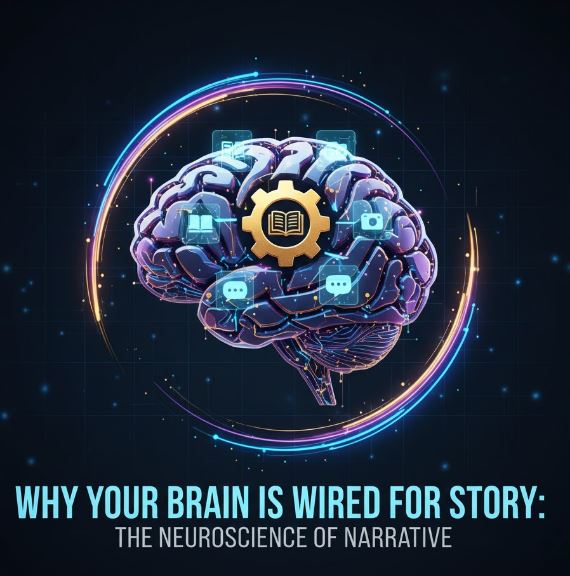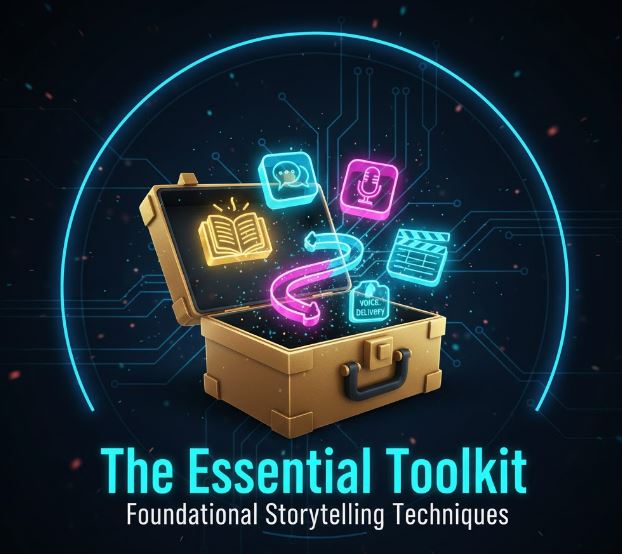In a world saturated with information, facts tell, but stories sell. They are the original virtual reality, the most powerful tool we have to transfer feelings, ideas, and meaning from one mind to another. Yet, many believe storytelling is a mystical gift bestowed upon a lucky few—novelists, filmmakers, and campfire orators. The truth is far more empowering: compelling storytelling is a craft, built on a foundation of learnable, repeatable storytelling techniques.
Whether you’re a marketer crafting a brand narrative, a leader inspiring a team, a salesperson closing a deal, or a teacher explaining a complex concept, mastering these techniques transforms your communication from mundane to magnetic. This guide will deconstruct the art of storytelling into a practical science, providing you with the essential storytelling techniques to connect deeply, persuade effectively, and be remembered long after your last word is spoken.

Why Your Brain is Wired for Story: The Neuroscience of Narrative
Before we dive into the techniques, it’s crucial to understand why stories are so potent. Cognitive psychology reveals that stories are not just entertainment; they are a fundamental way the human brain organizes and understands the world.
When you hear a list of facts, the language processing parts of your brain (Broca’s and Wernicke’s area) light up to decode the meaning. But when you are immersed in a well-told story, something remarkable happens. Your brain doesn’t just process the information; it simulates the experience.
If a character is running from danger, your motor cortex lights up as if you are running. When they feel joy or sadness, your brain releases dopamine or oxytocin, allowing you to empathize. This neural coupling is the secret sauce. By using effective storytelling techniques, you are not just informing your audience; you are making them feel, live, and experience your message firsthand. This is what builds unforgettable connections and drives action.

The Essential Toolkit: Foundational Storytelling Techniques
Here are the core storytelling techniques that you can start applying immediately to your work.
1. The Irresistible Story Loop: Hook, Hold, Payoff
Every great story follows a fundamental architecture that creates and resolves tension. Think of it as a contract with your audience: you promise a journey that is worth their time.
- The Hook: This is your opening gambit. It must immediately signal that something interesting is happening. It can be a provocative question (“What if you could double your revenue with one simple change?”), a moment of high tension (“There I was, standing on stage with my mind completely blank…”), or a relatable frustration (“Isn’t it exhausting trying to keep up with all the latest marketing trends?”). The goal is to trigger a “What happens next?” response.
- The Hold (The Journey): This is the body of your story, where you use the other techniques below to build empathy, create conflict, and escalate stakes. You introduce challenges, insights, and moments of discovery that keep the audience engaged.
- The Payoff (The Resolution): This is the satisfying conclusion. It’s the lesson learned, the problem solved, the transformation achieved. It must deliver on the promise of the hook and provide clear value—a new insight, a solution, or a powerful emotion.
2. The Power of “What If?” and the Familiar Strange
The most compelling stories often exist at the intersection of the relatable and the novel. This technique involves taking a universal human experience (the familiar) and twisting it with a unique premise or challenge (the strange).
- In Practice: A cybersecurity company doesn’t just talk about encryption. It starts with a story: “What if every time you sent an email, it was like a postcard anyone could read? For Sarah, a financial advisor, that nightmare became a reality…” This takes a familiar action (sending email) and introduces a strange, high-stakes consequence, making the technical problem feel intensely human and urgent.
3. Sensory Details: Show, Don’t Tell
This is the golden rule of narrative, and one of the most powerful storytelling techniques for creating immersion. Instead of stating an emotion or fact, paint a picture with sensory details that allows the audience to experience it for themselves.
- Tell: “He was nervous.”
- Show: “His palms were slick with sweat, and he could feel a single, cold bead of it tracing a path down his spine.”
- Tell: “The software made the team more efficient.”
- Show: “Where once the office was a symphony of frantic keyboard clatter and ‘Where’s that file?’ shouts, a quiet hum of focus settled in. Maria finished her report by 3 PM, a first in two years, and simply sat back, stunned by the silence.”
4. Character-Driven Conflict: The Engine of Engagement
No story exists without a character the audience cares about and a challenge they must overcome. In a business context, your “character” might be a customer, your company, or an industry archetype.
- The Relatable Protagonist: Your character should embody the hopes, fears, and frustrations of your target audience. Give them a name, a goal, and a point of view.
- The Central Conflict: This is the obstacle standing between the character and their goal. It could be:
- Human vs. Self: Overcoming self-doubt or a lack of knowledge.
- Human vs. Environment: Battling a chaotic market, a broken system, or outdated technology.
- Human vs. Adversary: Competing against a larger rival or an industry giant.
The conflict creates the dramatic tension that makes the audience invest in the outcome.
5. The Transformational Arc: The Promise of Change
The most satisfying stories are about transformation. The character ends the story in a different—ideally, better—place than they started. This arc is the core of persuasive storytelling because it demonstrates the value of your solution.
- The Before State: Paint a vivid picture of the “old world”—the pain, the frustration, the limitations. (e.g., “Before we implemented this system, our data was scattered across 12 different spreadsheets…”)
- The Catalyst: The moment of discovery or decision that initiates the change. (e.g., “That’s when we realized there had to be a better way.”)
- The Journey & Struggle: The process of implementing the change, including the obstacles faced.
- The After State: The “new world”—the benefits, the freedom, the success achieved. (e.g., “Now, with a single source of truth, we don’t just report on data; we anticipate trends and have cut reporting time by 70%.”)

Advanced Storytelling Techniques for Maximum Impact
Once you’ve mastered the foundations, these advanced storytelling techniques can add layers of sophistication and power.
- The False Start: Begin with a predictable, cliché story, then abruptly stop and restart with the real, more surprising and insightful story. (“You might expect this to be a story about how our hard work led to success. It’s not. It’s a story about a massive failure that taught us everything.”)
- The Starfish Moment: Use a small, seemingly insignificant detail that later becomes the key to the entire resolution. It makes the audience feel clever for spotting it and ties the narrative together with a satisfying “aha!” moment.
- Pacing with Silence: In oral storytelling, strategic pauses are a powerful technique. A pause before a key point creates anticipation; a pause after lets it sink in. It is the punctuation of the spoken word.
Weaving Storytelling Techniques into Your Professional World
- Marketing & Sales: Use customer success stories that follow the transformational arc. Instead of listing features, tell the story of a specific customer who had a problem (the conflict) and how your product guided them to a solution (the payoff).
- Leadership & Management: Use personal anecdotes of past failures and learnings to build trust and psychological safety. Frame company goals not as targets, but as a shared journey with a compelling mission.
- Presentations & Pitches: Start not with your company’s history, but with a “What if?” hook that paints a picture of the problem your audience faces. Make them the hero of the story, and position your solution as the essential tool or guide for their journey.
Conclusion: Your Story is Your Most Valuable Asset
Storytelling is not a deviation from “serious” work; it is the vehicle that gives serious work its meaning and impact. These storytelling techniques are your toolkit for building that vehicle. They empower you to cut through the noise, connect on a human level, and make your ideas resonate, stick, and inspire action.
The data is essential, but the story gives it a soul. Stop just presenting information. Start building worlds, creating characters, and guiding your audience on a transformational journey. Master these storytelling techniques, and you will master the ancient and irreplaceable art of capturing the human heart and mind.
If you’ve ever sat down to post and thought, “I don’t know what to say,” you’re not alone.
Most entrepreneurs and creators don’t struggle with the act of posting — they struggle
with finding words that connect.
The good news? You don’t need to reinvent the wheel. You already have stories that can
keep your content flowing consistently.
Here’s how storytelling helps you stay consistent and keep your audience engaged.
1. Stories Give You Endless Ideas
When you base your content on your experiences, you’ll never run out of things to say.
A client win, a personal challenge, or even a funny family moment can all be turned into
content.
2. Stories Build Connection (Not Just Noise)
Tips are helpful, but stories are memorable. They help your audience see themselves in
your journey. When you share how you overcame something, they believe they can do it
too.
3. Stories Create a Structure
My 1-2-3 Storytelling Method keeps content simple:
How to – teach something practical.
How I – share your version of it.
I… – wrap with a personal note or reflection.
This formula keeps you consistent because you always know where to start.
5. Stories Make Posting Feel Natural
When you post from your own life, you don’t feel like you’re “forcing content.” It feels
authentic — and that makes it easier to keep showing up.
If you want to stay consistent, start with your stories. Your audience doesn’t want perfect
content — they want real connection.
Ready to build your own storytelling system? Book my $49 Consultation Call and I’ll
show you how to:
● Turn everyday experiences into engaging content
● Plug your stories into a custom content calendar
● Use storytelling to build trust and authority online

